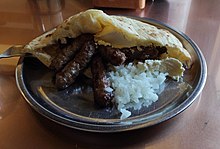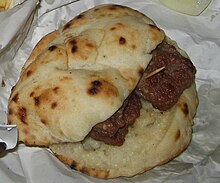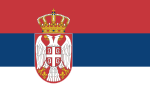Ćevapi
 | |
| Course | Main course |
|---|---|
| Place of origin | Bosnia and Herzegovina,[1] Serbia |
| Region or state | Balkans |
| Serving temperature | Hot |
| Main ingredients | Meat (lamb, veal, pork or beef), salt |
Ćevapi (Cyrillic: ћевапи, pronounced [tɕeʋǎːpi]) or ćevapčići (formal: diminutive; Cyrillic: ћевапчићи, pronounced [tɕeʋǎptʃitɕi]) is a grilled dish of minced meat found traditionally in the countries of southeast Europe (the Balkans). It is considered a national dish of Bosnia and Herzegovina and Serbia,[2] with Bosnia and Herzegovina taking steps in branding and placing them on the list of intangible heritage, with a nomination for inclusion on the UNESCO List of Intangible Cultural Heritage. Ćevapi are also common in Albania, Bulgaria, Slovenia,[3] Croatia,[4][5][6] Kosovo, Montenegro, North Macedonia and Western Romania.
They are usually served in groups of five to ten pieces on a plate or in a flatbread (lepinja or somun), often with chopped onions, kajmak, ajvar (optional), and salt.
Bosnian ćevapi are made from two types of minced beef meat, hand-mixed and formed with a funnel, while Serbian ćevapčići are made of beef, lamb, pork, or a mixture.
Name and etymology
[edit]The word ćevap is derived from the Ottoman Turkish kebap. The word is sometimes used in conjunction with the common South Slavic diminutive ending -čići/-čiči. Albanian: qebapa; Bulgarian: кебапчета, romanized: kebapcheta; Bosnian: ćevapi / ћевапи; Macedonian: ќебапчиња, romanized: ḱebapčinja; Slovak: čevabčiči; Slovene: čevapčiči. The word ćevapi is plural; the singular form ćevap is rarely used, as a typical serving consists of several ćevapi.
History
[edit]
Ćevap arrived in Bosnia and Herzegovina as a variant of Turkish kebab around 1500. Although most first think of "doner kebab", kebab is translated from Turkish as "grilled meat". In the beginning, this simple dish was not too well known and popular among South Slavic peoples. Today, this dish is popular in many areas, such as those from Travnik, Banja Luka, Leskovac, etc., but Sarajevo's ćevapi stands out, which occupies a cult place in the culture and tourism of the inhabitants of the Bosnia and Herzegovina capital [7]
At the beginning of the 20th century, the pace of life became faster, which contributed to the popularization of grilled food. Sarajevo was not bypassed by the enthusiasm for barbecued food, and so, during the Kingdom of Yugoslavia, the first ćevapi shop sprang up in this city. It was located in a vaqf store, to the left of the entrance to today's restaurant "Aeroplan" on the bazaar, near the sweet corner. It was approached from Sarači Street and belonged to the complex of Gazi Husrev Bey's mansion. It had a concept similar to today's fast food stores; there were no seats, but kebabs were sold from the counter, by the piece.[8]
During the Ottoman administration, hajduks (rebels, outlaws) made the hajdučki ćevap ("hajduk ćevap"), which was easy to make, out of pieces of meat and smoked lard, on a skewer roasted over fire.[9] The recipe of the Leskovački ćevap ("Leskovac ćevap"), a local specialty of Serbia, was based on traditional pljeskavica (meat patty[10]), formed as ćevap.
Leskovac has a long history of grill shops.[11] In Belgrade, ćevapčići first came from Leskovac in the 1860s, into the kafana "Rajić" at the Great Marketplace (today Studentski Trg), from where they quickly spread across the city, and subsequently, country.[12][13] The industry quickly multiplied, as ćevapčići was the drinking public's favourite.[13]
The ćevapčići were served at shops, known as ćevabdžija (pl. ćevabdžije).[14] According to a 1927–28 study in Belgrade, people either ate in the restaurant or outside ("on the kaldrma"), often take-away.[14] The shops served from early morning to 10 AM; often the dish was bought for breakfast.[14]
Before the 1930s, they spread to the rest of Yugoslavia, including east of Serbia and the Macedonia region.[12] By 1932, ćevapčići were regarded a local specialty in southern Serbia, Skopje and Peć.[15] In 1933, the first street food vendor appeared in Maribor, Slovenia, who came from Leskovac, and served grilled meat, including ćevapčići.[16] In 1940, ten pieces cost one Yugoslav dinar.[17] In the second half of the 20th century, ćevapčići and other Oriental dishes became prominent in Croatian cuisine.[18] The Leskovac-styled grilled meat, including ćevapčići, have today become part of everyday-diet in Slovenia.[19] Today, ćevapčići are found outside former Yugoslavia in the diaspora communities.
Today, the grill shops are known as ćevabdžinica (pl. ćevabdžinice).
Leskovac organizes an annual grill festival, the Leskovac Grill Festival, as a showcase of ćevapi and other grilled meat.
Varieties
[edit]There are variations in meat content and seasoning, usually salt and pepper. The dish is kept simple, and traditionally served with a type of flatbread similar to Turkish Bazlama, called Somun (in Sarajevo) or a more "bready" variant Lepinja (elsewhere), with chopped onions and/or kajmak and yogurt as appetizer.
Sarajevo-style ćevapi
[edit]
Sarajevo-style ćevapi (Sarajevski ćevapi) have standardised production and are made exclusively from beef, from cattle that is between 6 and 19 months old. The raw individual product of "Sarajevo ćevap" should be the traditional length of "four fingers together" (between 6 and 10 cm), with a diameter of 1 to 2 cm, and an average portion (10 pieces) weighing 200 to 250 grams. They have to be produced in administrative area of Sarajevo Canton, while raw material can be obtained from other localities.[20]
In 2024, production of Sarajevo-style ćevap was standardised and it received Protected designation of geographical origin by Food Safety Agency of Bosnia and Herzegovina.[21]
Banja Luka-style ćevapi
[edit]
Banja Luka-style ćevapi (Banjalučki ćevapi) differ from all others because they are prepared as a meat tile typically consisting of four ćevapi connected in a row. They are usually made just with ground beef, salt, and pepper. According to the traditional recipe, garlic is added to "Banjalučki ćevap", the mixture must be aged for at least 36 hours at a very low temperature.[22]
In 2024, Association for the Preservation of the Guaranteed Tradition of the "Banjalučki ćevap" specialty, applied for protected designation of geographical origin.[23]
Other
[edit]Travnički ćevapi originates from the city of Travnik in Bosnia and Herzegovina. The ćevapi are made with a combination of beef, veal, mutton, and lamb, with the addition of salt, pepper, and a bit of baking soda. When grilled, the meat is often brushed with a clear broth that was prepared with beef bones and mutton.
Tuzlanski ćevapi comes from Tuzla. The small meat logs are usually made with a combination of ground mutton, beef, and lamb (usually in a ratio of 2:1:1), although some places prepare them only with beef. The meat is mixed by hand and seasoned with salt and pepper, and it is recommended to leave the meat combination in the refrigerator for a few hours or a whole day before the preparation.
Heritage
[edit]In Bosnia and Herzegovina, ćevapi are considered for branding and nomination for the UNESCO List of Intangible Cultural Heritage. Meanwhile, Banjalučki ćevap, a variety from Banja Luka, is already included in the list of intangible cultural heritage and on the Tentative List of Intangible Heritage of Bosnia and Herzegovina by the State Commission of Bosnia and Herzegovina for UNESCO.[24][25]
See also
[edit]- Balkan cuisine
- Mititei, a Romanian dish
- Kebapche, a Bulgarian dish
- Kofta
References
[edit]- ^ "Ground meat dish: Ćevapi". tasteatlas.com.
- ^ "Ćevapčići". Encyclopædia Britannica. 2021. Retrieved December 27, 2021.
- ^ Radojičić, Dragana (2010-10-15). "Serbian Dishes on the Slovenian Table". Traditiones. 39 (1): 111–122. doi:10.3986/Traditio2010390110. ISSN 1855-6396.
- ^ Encyclopædia Britannica (2002). The New Encyclopædia Britannica. Vol. 1. Encyclopædia Britannica. ISBN 978-0-85229-787-2.
- ^ Ember, Melvin (2001). Countries and Their Cultures: Saint Kitts and Nevis to Zimbabwe. Macmillan Reference USA. p. 68. ISBN 9780028649467.
- ^ "Cevapcici". SBS Australia. 3 May 2014. Retrieved June 8, 2019.
- ^ citation needed
- ^ Sarić, Esma. "Kratka istorija sarajevskog ćevapa".
- ^ Yugoslavia. D. McKay. 1962.
... Turkish occupation the outlaws produced hajduCki cevap (the haiduk was the maquis of the period) which was easy to make and tasty. It consists of pieces of meat, potatoes and smoked lard stuck on a skewer and roasted over a roaring fire.
- ^ Laurence Mitchell (2013). Serbia. Bradt Travel Guides. p. 83. ISBN 978-1-84162-463-1.
For the main course, the most popular meat dishes are pljeskavica (meat patties, usually a mixture of pork, beef and lamb, sprinkled with spices, then grilled and served with onion)
- ^ Sergije Dimitrijević (1983). Istorija Leskovca i okoline. Narodni muzej.
Гастрономски специјалитет Лесковца били су 'ћевапчићи и чувене лесковачке кобасице печене на роштиљу.4 Лесковац је одувек имао чувене ћевабџије. У периоду који описујемо најпознатије лесковачке ћевабџије биле су ...
- ^ a b Darko Spasić, Branislav Nušić. "Прилог историјату ћевапчића" (in Serbian). Srpsko nasleđe.
- ^ a b Branislav Đ Nušić; Aleksandra Vraneš (1996). Beogradska čaršija. Ars Libri. pp. 22–30.
- ^ a b c Srpski etnografski zbornik. Vol. 42. Akademija. 1928. pp. 121–122.
- ^ Milivoja M. Savić (1932). Naša industrija, zanati, trgovina i poljoprivreda: njine osnovice, stanje, odnosi, važnost, putevi, prošlost i budućnost. Izd. Ministarstva trgovine i industrije. p. 244.
- ^ Jacobs, Marc; Scholliers, Peter (2003). Eating Out in Europe: Picnics, Gourmet Dining and Snacks Since the Late Eighteenth Century. Berg Publishers. p. 133. ISBN 9781859736586.
- ^ Etnografski muzej u Beogradu; Borivoje M. Drobnjaković (1940). Glasnik: Bulletin.
Десет ћевапчића за данар, десет за динар! Скупи се гомила и гледа: Добри ћевапчићи, па и велики, а десет за ...
- ^ Ivo Goldstein (1999). Croatia: A History. McGill-Queen's Press – MQUP. ISBN 978-0-7735-2017-2.
To all this must be added, especially in the second half of the twentieth century, the influence of typical oriental-Turkish dishes and ways of cooking (barbecue, cevapcici).
- ^ Dragana Radojičić (2010). "Serbian Dishes on the Slovenian Table". Traditiones. 39 (1): 111–122. doi:10.3986/Traditio2010390110.
[Abstract] The research included immigration trends from Serbia to Slovenia from 1918 to the present, and how these are reflected in the acceptance of food-related products and dishes that originated in Serbia and have become part of Slovenians' everyday diet.
- ^ "Oznake porijekla, geografskog porijekla i garantirano tradicionalnog specijaliteta". Agencija za sigurnost hrane Bosne i Hercegovine (in Bosnian).
- ^ "Sarajevski ćevap bit će zaštićen i na nivou EU, a nakon toga slijedi i zaštita somuna". www.klix.ba (in Croatian).
- ^ "Oznake porijekla, geografskog porijekla i garantirano tradicionalnog specijaliteta". Agencija za sigurnost hrane Bosne i Hercegovine (in Bosnian).
- ^ "Službeni List- Pregled Dokumenta". www.sluzbenilist.ba.
- ^ "PRELIMINARNA LISTA NEMATERIJALNE KULTURNE BAŠTINE BOSNE I HERCEGOVINE". unescobih.mcp.gov.ba. Retrieved 1 January 2024.
- ^ Maja Celing Celić (4 May 2018). "Banjalučki ćevap će na UNESCO-vu listu, a Travničani će svoj brendirati". Agroklub.ba (in Croatian). Retrieved 1 January 2024.


